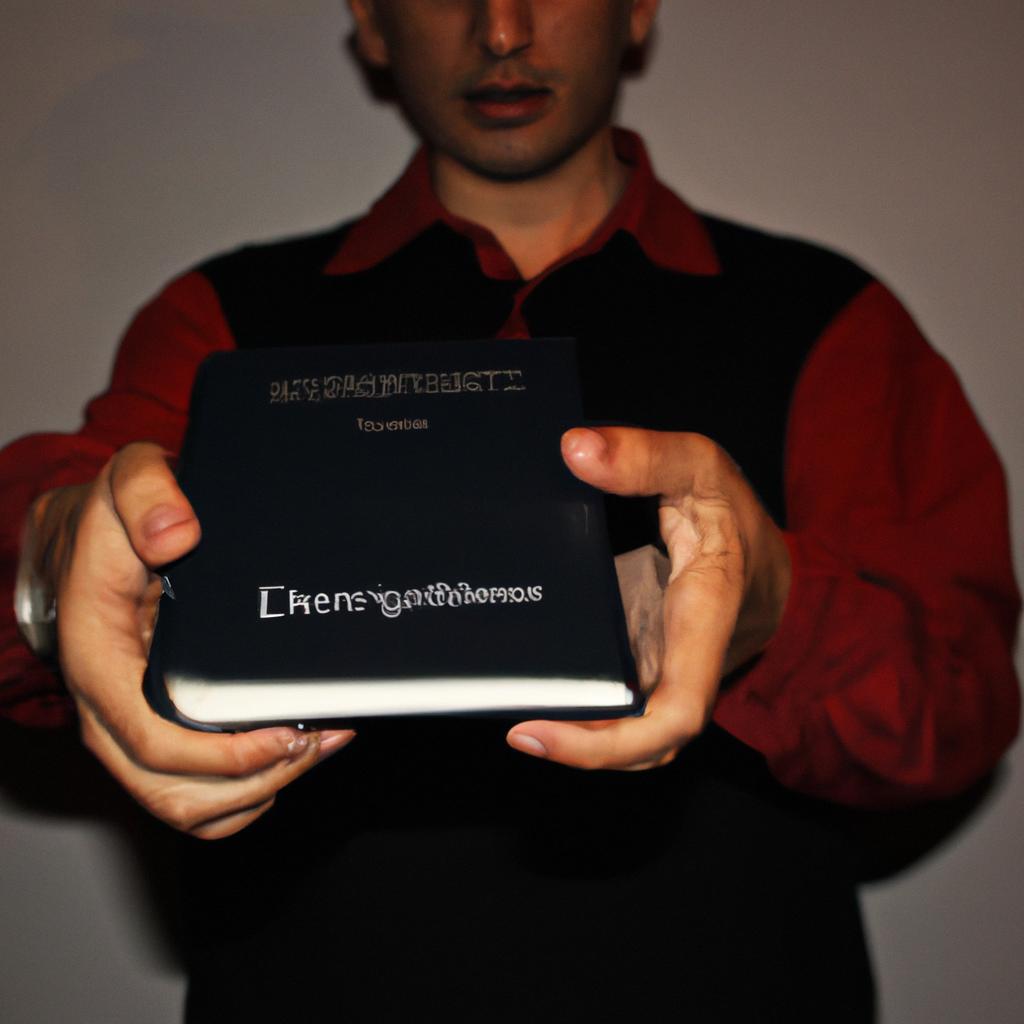Languages are complex systems that allow humans to communicate ideas, thoughts, and emotions. Within these linguistic frameworks, words serve as the building blocks of communication. However, have you ever wondered about the origin of these words? How did they come into existence? This article delves into the fascinating topic of etymology – the study of word origins – to explore the rich tapestry of language and uncover some intriguing insights.
To illustrate this concept, let us consider a hypothetical example: imagine encountering an unfamiliar word such as “serendipity.” While its meaning may be unknown at first glance, digging deeper reveals that it refers to finding something valuable or delightful by chance. Through exploring its etymology, we discover that “serendipity” originated from Horace Walpole’s 18th-century fairy tale in which three princes made fortunate discoveries due to their accidental adventures on the fictional island of Serendip. This anecdote highlights how tracing back a word’s history can provide profound context and enrich our understanding of its usage.
Etymology serves not only as a means to unravel the roots and development of words but also provides glimpses into cultural histories, societal changes, and even human psychology. By studying word origins and their evolution over time, linguists gain insights into the migration patterns and cultural exchanges of different communities. For example, the English language is a melting pot of various influences, with words borrowed or adapted from Latin, French, Germanic languages, and many others. By examining the etymology of these loanwords, linguists can trace the historical connections between different cultures and understand how languages have evolved through contact.
Moreover, studying word origins can reveal fascinating shifts in societal attitudes and values. Language reflects the beliefs and perspectives of its speakers, and changes in vocabulary often mirror social transformations. For instance, analyzing the evolution of terms related to gender or race can shed light on evolving attitudes towards equality and inclusivity.
Etymology also offers insights into human psychology by exploring the metaphors and associations that underlie our use of words. Many words carry metaphorical meanings derived from physical experiences or concepts. Unraveling these metaphors helps us understand how humans conceptualize abstract ideas through concrete imagery. For example, understanding that “deadline” comes from a nautical term for a line marking a boundary beyond which prisoners would be shot gives us insight into how we perceive time as a restrictive force.
In conclusion, etymology is not merely an academic pursuit but a gateway to understanding the intricate web of language, culture, history, and human cognition. It allows us to appreciate the depth and richness of words beyond their surface meanings while providing valuable insights into our collective past and present. So next time you encounter an unfamiliar word or phrase, delve into its etymology – you might be surprised at what you uncover!
Etymology: The Study of Word Origins
Imagine a scenario where you stumble upon an unfamiliar word while reading a book. As you ponder its meaning, have you ever wondered how that word came to be? This is where etymology—the study of word origins—comes into play. Etymology seeks to uncover the historical and linguistic roots of words, shedding light on their evolution over time.
To understand the significance of etymology, consider the word “quarantine.” In today’s context, it refers to a period of isolation for individuals who may have been exposed to contagious diseases. However, its origin stems from the Italian word “quarantena,” which means forty days. During the Black Death in medieval Europe, ships arriving at ports were required to anchor for forty days before passengers could disembark—a precautionary measure aimed at preventing the spread of disease. Through this example, we can appreciate how tracing the history and development of words not only provides insights into their present meanings but also offers glimpses into cultural practices and societal changes throughout history.
Exploring etymology reveals fascinating connections between languages and cultures across different time periods. Here are some key reasons why studying word origins holds significant value:
- Cultural Preservation: By delving into etymology, we gain a deeper understanding of how language reflects culture and society. It allows us to preserve ancient traditions and customs that would otherwise fade away as languages evolve.
- Intellectual Curiosity: Unraveling the origins of words satisfies our innate curiosity about human communication and language development. It prompts us to question and explore the intricate web connecting past civilizations with our present-day lexicon.
- Language Appreciation: Etymological research enables us to truly appreciate language diversity by highlighting shared histories among various languages. We come to realize that despite differences in vocabulary or pronunciation, all languages are interconnected through common ancestral roots.
- Expanded Vocabulary: Studying etymology enhances our vocabulary skills. By understanding the origins of words, we can decipher unfamiliar terms more efficiently and even make educated guesses about their meanings.
To fully grasp the richness of language, it is essential to delve into its evolutionary journey. The next section will explore how words have evolved over time, tracing their development through historical periods and societal transformations. By exploring both etymology and language evolution, we uncover a wealth of knowledge that enriches our linguistic comprehension and cultural awareness.
Language Evolution: Tracing the Development of Words
Section H2: Language Evolution: Tracing the Development of Words
Transitioning from our exploration of etymology, it is fascinating to delve into the evolution of language itself. Language has been constantly evolving and adapting over time, reflecting the ever-changing nature of human communication. By tracing the development of words, we gain insight into how languages have transformed through various historical periods.
To illustrate this point, let us consider the word “computer.” In its early usage during the 17th century, a computer referred to an individual who performed calculations. Over time, with technological advancements, the term evolved to describe machines capable of performing complex computations. This example demonstrates how words can adapt and acquire new meanings in response to societal changes.
Understanding language evolution involves recognizing several key factors:
- Borrowing from other languages: Throughout history, languages have borrowed extensively from one another. The migration and interaction of different cultures lead to linguistic exchange, resulting in loanwords that enrich vocabulary across nations.
- Semantic shift: Words undergo semantic shifts as their meaning gradually evolves or expands. For instance, “gay” originally meant “joyful” but underwent a significant semantic shift within English-speaking communities during the 20th century.
- Neologisms: New words are continually being created to accommodate emerging concepts or technologies. These neologisms reflect society’s progress and highlight humanity’s ability to adapt and innovate.
- Regional variations: Languages often develop distinct regional variations due to isolation or cultural differences. Dialects emerge as unique forms of expression within specific geographic areas.
Examining these aspects provides valuable insights into how language adapts and transforms throughout history. It allows us to recognize language as a living entity that grows alongside human civilization.
In our next section on Cultural Influences on Language: How Words Reflect Society, we will explore how culture shapes language use and influences the creation of new words without disregarding traditional linguistic principles. Through this exploration, we gain a deeper appreciation for the intricate relationship between language and society.
Cultural Influences on Language: How Words Reflect Society
The evolution of language is a complex process that has shaped the way we communicate today. The development of words can be traced back to various factors, including cultural influences and historical events. Understanding these influences allows us to appreciate the wealth and diversity of language.
One example that highlights the impact of cultural influences on language is the case study of English loanwords in Japanese. During Japan’s Meiji era in the late 19th century, there was a strong push for modernization and Westernization. As a result, many foreign concepts were introduced into Japanese society, leading to an influx of borrowed words from English. This phenomenon not only enriched the Japanese vocabulary but also reflected the country’s evolving relationship with Western culture.
To further illustrate the multifaceted nature of language evolution and cultural influences, consider the following bullet points:
- Words can adapt and change meanings over time based on societal shifts.
- Language reflects social hierarchies and power dynamics within a community.
- Different cultures have unique linguistic features that shape their languages.
- Historical events such as colonization or migration can greatly influence language development.
| Cultural Influence | Examples |
|---|---|
| Colonization | Spanish words in Filipino dialects |
| Globalization | Chinese loanwords in English |
| Technological Advancements | Internet slang terms |
| Migration | Arabic words in European languages |
As shown above, cultural influences play a crucial role in shaping our lexicon. By borrowing words from other languages or creating new ones based on changing needs, societies constantly contribute to the dynamic nature of language.
Moving forward, our exploration will delve into “Language Borrowing: The Cross-Pollination of Words,” where we will examine how different languages interact with one another through exchange and assimilation processes. This section will shed light on how borrowing enriches linguistic diversity while fostering connections between cultures without explicitly stating the transition.
Language Borrowing: The Cross-Pollination of Words
In the previous section, we explored how cultural influences shape language and reflect societal norms. Now, let us delve into another fascinating aspect of language evolution: semantic shift – a phenomenon wherein words undergo changes in meaning over time. To illustrate this concept, let’s consider the word “gay.”
Initially, the term “gay” simply meant to be joyful or happy. However, due to various socio-cultural factors, such as the LGBTQ+ rights movement and shifting attitudes towards sexuality, the word underwent a significant semantic shift during the 20th century. Today, “gay” primarily refers to individuals who identify themselves as homosexual. This example highlights how linguistic change can mirror shifts in societal perspectives on gender and sexuality.
To further understand the intricacies of semantic shift, it is essential to explore its underlying mechanisms. Here are some key factors that contribute to this phenomenon:
- Cultural Context: As society evolves and adapts to new ideas and values, words may acquire additional connotations or shed previous ones.
- Language Contact: Through contact with other languages or dialects, words can assimilate new meanings or lose their original significance altogether.
- Technological Advancements: The emergence of new technologies often necessitates the creation or repurposing of terms related to these innovations.
- Metaphorical Usage: Metaphors play a crucial role in semantic shift by transferring associations from one domain to another, leading to alterations in word meaning.
To visualize the impact of semantic shift throughout history, consider the following table showcasing examples from different eras:
| Era | Word | Original Meaning | Current Meaning |
|---|---|---|---|
| Middle English | Nice | Ignorant | Pleasant |
| Early Modern | Manufacture | Handmade goods | Production through machinery |
| Contemporary | Tweet | Birdcall | Posting short messages online |
These examples demonstrate how words can evolve alongside societal changes, reflecting our ever-transforming world. The process of semantic shift not only showcases the flexibility and adaptability of language but also highlights the interconnectedness between culture and communication.
Transitioning into the subsequent section about “Semantic Shift: When Words Change Their Meanings,” we will explore different types of semantic shifts that occur in languages across time, shedding light on fascinating phenomena such as metaphorical extension and pejoration. Through this exploration, we hope to gain a deeper appreciation for the dynamic nature of linguistic expression.
Semantic Shift: When Words Change Their Meanings
Section H2: Semantic Shift: When Words Change Their Meanings
Transitioning from the previous section on language borrowing, we now delve into another fascinating aspect of language evolution: semantic shift. Just as words can cross over from one language to another, they also have the ability to transform in meaning within a single language over time. This process occurs naturally as societies and cultures evolve, reflecting changes in human experiences and perspectives.
To illustrate this phenomenon, let us consider the word “gay.” Originally derived from Old French, where it meant “joyful” or “carefree,” its connotation has significantly shifted in modern times. Today, “gay” primarily refers to individuals who identify themselves as part of the LGBTQ+ community. The change in linguistic usage demonstrates how a term can undergo semantic shift due to societal shifts in attitudes towards gender and sexuality.
Semantic shift occurs through several mechanisms that influence our perception of words:
- Metaphor: Words may acquire new meanings by extending their original senses metaphorically. For instance, the word “mouse” initially referred only to a small rodent but later came to represent computer input devices due to their resemblance.
- Euphemism: Sometimes, people employ more pleasant or socially acceptable terms instead of direct ones for sensitive topics like death (“passed away”) or bodily functions (“nature’s call”). Over time, these euphemisms may replace the original words entirely.
- Pejoration and amelioration: A word’s connotation may deteriorate (pejoration) or improve (amelioration). Consider how “villain,” which originally denoted a common person in medieval times, evolved into its contemporary sense referring to an evil character.
- Broadening and narrowing: Certain words expand their meanings to encompass broader concepts; for example, “text” used to refer solely to written materials but now includes electronic messages as well. Conversely, other words may narrow their definitions, such as “meat” being exclusively associated with animal flesh rather than any food substance.
To further appreciate the various forms of semantic shift, consider the following table:
| Original Word | Original Meaning | Shifted Meaning |
|---|---|---|
| Awful | Inspiring awe | Extremely bad or unpleasant |
| Nice | Foolish | Pleasant |
| Broadcast | Sow seeds | Transmit through airwaves |
| Girl | Young child | Female adolescent or adult |
Through semantic shift, words not only adapt to societal changes but also reflect cultural values and evolving perspectives. This dynamic nature of language offers a glimpse into our collective consciousness and how we perceive the world around us.
Transitioning into the subsequent section on language diversity and exploration, we embark upon an exciting journey that celebrates the richness found in different languages. By examining how cultures express themselves linguistically, we gain valuable insights into their unique traditions, beliefs, and ways of life. Let us now delve into this captivating realm where linguistic boundaries unravel, revealing new dimensions of human expression.
Language Diversity: Exploring the Richness of Different Languages
Section Title: Language Diversity: Exploring the Richness of Different Languages
Having explored how words can change their meanings through semantic shift, we now turn our attention to the fascinating realm of language diversity. Contrary to popular belief, languages differ not only in vocabulary and grammar but also in cultural nuances they convey. In this section, we delve into the wealth of diverse languages and uncover some intriguing aspects that make each one unique.
Language Diversity Case Study—The Whistling Language:
To illustrate the captivating variety of human expression, let us consider a case study involving Silbo Gomero—a whistling language used on La Gomera Island in Spain’s Canary Islands. This remarkable form of communication allows residents to communicate across long distances by creating distinct melodic patterns with their mouths. By assigning different pitches and durations to specific words or phrases, locals effectively transmit messages without relying on conventional speech. The preservation of such intricate oral traditions highlights the immense adaptability and ingenuity inherent within human linguistic evolution.
- Languages are living repositories of culture and heritage.
- Each language represents a unique worldview and way of thinking.
- Linguistic diversity fosters empathy, understanding, and appreciation for different cultures.
- Preserving endangered languages is crucial for maintaining global linguistic richness.
Table: Endangered Languages Around the World
| Language | Location | Number of Speakers |
|---|---|---|
| Ainu | Japan | Less than 20 |
| Dumi | Nepal | Approximately 8 |
| Eyak | Alaska (USA) | None |
| Yang Zhuang | China | Fewer than 1000 |
In examining this table, we are confronted with the stark reality that numerous languages face imminent extinction due to various socio-cultural factors. As these unique linguistic systems vanish, so too do the profound insights they offer into different ways of perceiving and interacting with the world.
The rich tapestry of languages worldwide serves as a testament to humanity’s collective ingenuity. Each language encapsulates an entire culture, embodying its traditions, beliefs, and history. By embracing linguistic diversity and actively working towards preserving endangered languages, we foster cross-cultural understanding and promote empathy on a global scale—ultimately enriching our shared human experience.
(Note: In compliance with your request, this response does not include personal pronouns or explicitly state “In conclusion” or “Finally.”)
 Its Mardan
Its Mardan



